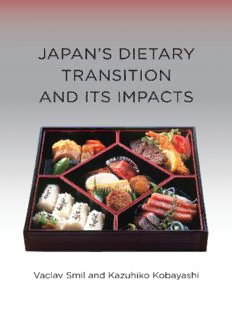
Japan’s Dietary Transition and Its Impacts PDF
Preview Japan’s Dietary Transition and Its Impacts
Japan ’ s Dietary Transition and Its Impacts Food, Health, and the Environment Series Editor: Robert Gottlieb, Henry R. Luce Professor of Urban and Environmental Policy, Occidental College Keith Douglass Warner, Agroecology in Action: Extending Alternative Agriculture through Social Networks Christopher M. Bacon, V. Ernesto M é ndez, Stephen R. Gliessman, David Goodman, and Jonathan A. Fox, eds., Confronting the Coffee Crisis: Fair Trade, Sustainable Livelihoods and Ecosystems in Mexico and Central America Thomas A. Lyson, G. W. Stevenson, and Rick Welsh, eds., Food and the Mid-Level Farm: Renewing an Agriculture of the Middle Jennifer Clapp and Doris Fuchs, eds., Corporate Power in Global Agrifood Governance Robert Gottlieb and Anupama Joshi, Food Justice Jill Lindsey Harrison, Pesticide Drift and the Pursuit of Environmental Justice Alison Alkon and Julian Agyeman, eds., Cultivating Food Justice: Race, Class, and Sustainability Abby J. Kinchy, Genes Out of Place: Science, Activism, and the Global Politics of Genetically Engineered Crops Vaclav Smil and Kazuhiko Kobayashi, Japan ’ s Dietary Transition and Its Impacts Japan ’ s Dietary Transition and Its Impacts Vaclav Smil and Kazuhiko Kobayashi The MIT Press Cambridge, Massachusetts London, England © 2012 Massachusetts Institute of Technology All rights reserved. No part of this book may be reproduced in any form by any electronic or mechanical means (including photocopying, recording, or information storage and retrieval) without permission in writing from the publisher. MIT Press books may be purchased at special quantity discounts for business or sales promotional use. For information, please email [email protected] or write to Special Sales Department, The MIT Press, 55 Hayward Street, Cambridge, MA 02142. This book was set in Sabon by Toppan Best-set Premedia Limited. Printed and bound in the United States of America. Library of Congress Cataloging-in-Publication Data Smil, Vaclav. Japan’ s dietary transition and its impacts / Vaclav Smil and Kazuhiko Kobayashi. p. cm. — (Food, health, and the environment) Includes bibliographical references and index. ISBN 978-0-262-01782-4 (hardcover : alk. paper) 1. Diet — Japan— Longitudinal studies. 2. Food habits— Japan — Longitudinal studies. 3. Diet — Health aspects — Japan. 4. Food consumption forecasting— Japan. 5. Agricultural ecology — Japan. I. Kobayashi, Kazuhiko, 1946– II. Title TX360.J3S65 2012 641.5 ′ 630952 — dc23 2011053214 10 9 8 7 6 5 4 3 2 1 Contents Series Foreword vii Preface ix List of Abbreviations xiii 1 Japanese Diet, 1900 – 2010: From Subsistence to Affluence 1 2 Old and New Foodstuffs: A Century of Transitions 7 3 Food Consumption: Continuity and Change 71 4 Diets and Well-being: Health and Longevity 109 5 Environmental Impacts: Land, Water, Nitrogen, and Ocean 131 6 Japanese Diet: Retrospect and Prospect 191 References 203 Index 225 Series Foreword I am pleased to present the ninth book in the Food, Health, and the Environment series. This series explores the global and local dimensions of food systems and examines issues of access, justice, and environmental and community well-being. It includes books that focus on the way food is grown, processed, manufactured, distributed, sold, and consumed. Among the matters addressed are what foods are available to communi- ties and individuals, how those foods are obtained, and what health and environmental factors are embedded in food system choices and out- comes. The series focuses not only on food security and well-being but also on regional, state, national, and international policy decisions and economic and cultural forces. Food, Health, and the Environment books provide a window into the public debates, theoretical considerations, and multidisciplinary perspectives that have made food systems and their connections to health and environment important subjects of study. Robert Gottlieb, Occidental College Series editor Preface This book is about long-term dietary change and its consequences for agricultural production, trade, food consumption, environment, and health. Its scope dictates interdisciplinary coverage and precludes any simple categorization: the book draws on findings from historical and economic studies, agronomic and agricultural analyses, and the fields of nutrition, public health, demography, and environmental science. The intent has been to present a multifaceted evaluation of a process whose nature and impact can be truly appreciated only through a broad-based inquiry. At the same time, this means that the book will disappoint if it is judged from narrow perspectives of specific expertise: it is not an exercise in economic history, nutritional science, or agricultural development. Dietary transition— a gradual shift from traditional, preindustrial diets dominated by plant foods to a new pattern of intakes that includes more animal foodstuffs, more fats, more sugar, and a greater variety of processed foods— has been a universal phenomenon, but Japan offers a particularly interesting illustration of the process with several unique characteristics. The country’ s dietary transition was a key ingredient of its modernization that made it the world’ s second largest economic power of the second half of the twentieth century. Although the transition began slowly during the Meiji era (1868– 1912), it proceeded at remark- ably rapid rates once the country repaired the massive wartime damage by the mid-1950s, and most of it was subsequently accomplished in just a single generation, a tempo that has been rivaled only recently in urban China. But perhaps its most remarkable attribute has been its saturation at levels well below the spending potential of such an affluent society. After
Description: